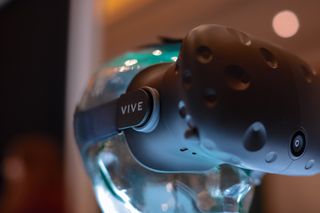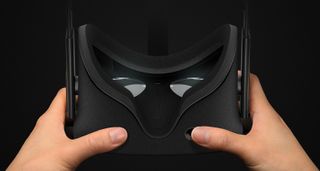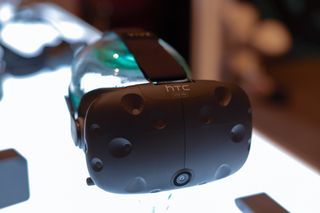Tested: Oculus Rift vs HTC Vive Pre

Comparing VR headsets—whether it’s the Oculus Rift vs. the HTC Vive, or one generation of Rift vs. another—invariably means fighting a losing battle against my own memory. Usually hours, days, or even months separate my tests. It may be easy to remember the overall experience from a VR session, but comparing head tracking or display brightness or the screen door effect purely from memory is impossible. When it comes to those minute details, taking notes just doesn’t cut it.
CES this year was different: for the first time, I got to try out the HTC Vive and the Oculus Rift back-to-back (big thanks to AMD for accommodating me and providing the time for multiple demos). Testing the two HMDs together solidified a few things for me: the Vive definitely offers a larger field of view, the Oculus Rift is definitely the lighter and more refined headset, and both of them have to be adjusted perfectly to offer a clear, focused image.
Right now, the best VR experience is a combination of Oculus VR and Vive VR. Both have their own strengths. If wishes were magic VR amalgamations, I’d use the Vive’s screen and tracking system in the Oculus Rift’s body, with Oculus Touch controllers on my hands. But since most of us are going to be buying one headset or the other, here are my observations from back-to-back testing.
The displays
The Vive’s field of view is notably larger—specifically, taller—than the Oculus Rift’s. It’s a fairly striking difference when you look at them in quick succession. The Vive definitely doesn’t fill your entire field of view, but the extra verticality is a real plus. If the Oculus Rift is a movie shot at 2.35:1 aspect ratio, the Vive is more 16:9. That’s an imperfect comparison (for one thing, I like movies shot at 2.35:1!) but in VR, the Oculus experience feels a bit more like looking through a window.
When both the Oculus Rift and Vive are perfectly adjusted and in focus on my head, the actual display looks virtually identical, with a very minimal screen door effect. There might be some small differences in brightness, but they should look identical—they’re actually using the very same OLED panel. There are differences in the implementation of that panel and definitely differences with the lenses for the two systems. The Vive’s lenses give a view of a wider portion of the display, and do so without creating any significant distortion.

Both headsets have IPD (inter-pupillary distance) adjusters, but the Vive’s isn’t quite as obvious. It’s a small piece of plastic you turn, as opposed to the slider on the bottom of the Oculus Rift. I found adjusting the slider on the Oculus Rift made a huge difference in focus and clarity, as I positioned the lenses properly for my eyes. I found the effect on the Vive much less obvious, and wasn’t even sure it was working, at first. It seemed to make a very small difference in focus, but perhaps I wasn’t adjusting it to its extremes (but I did turn the little knob a lot).
Despite using the IPD adjustment on the Oculus Rift, I was seeing a half moon-like ring of the display on the left and right periphery of my vision, and it felt like i needed to be able to adjust the IPD outwards more to compensate. It’s a hard thing to describe—almost like a reflection from the edges of the lenses. I think this was an anomaly with the fit of the particular headset I was trying, as I haven’t always experienced this vision effect on other Oculus Rift Crescent Bay dev kits or the final consumer Rift. But the fit seemed right, as the display in the center of my vision was in sharp focus.
The biggest gaming news, reviews and hardware deals
Keep up to date with the most important stories and the best deals, as picked by the PC Gamer team.
Fit and weight
The Vive sits heavily on your head. I’ve seen other writers remark on it feeling surprisingly light, and frankly, I think they’re crazy. Wearing it for 5-10 minutes isn’t going to cause you pain, and for its size and the technology crammed into it, the Vive is already an impressive piece of kit. But it does weigh on the front of your head, and it will cause neck fatigue with longer gaming sessions. And probably shorter ones. The weight has another downside: keeping the headset firmly in place and in focus will mean strapping it tightly to your face, or else it’s slowly going to slide its way out of position. It really doesn’t take much to shift the image quality from ‘perfect’ to ‘pretty good,’ and when the screen is an inch away from your eyeballs, that discrepancy is very noticeable. For a short demo, I had it strapped on uncomfortably tight to really scrutinize the display. Strapping the thing on comfortably while keeping it securely in position is going to be a challenge.
The Oculus Rift is absolutely the more comfortable headset. It’s lighter and much easier to keep in place, partially thanks to its strap system, but mostly, I think, due to its weight. It’s the more comfortable device to handle thanks to its fabric covering. The Vive really feels like development hardware, bursting with raw potential but still a bit ungainly. Putting on the Oculus immediately afterward makes it feel much more like a consumer-ready, heavily iterated piece of tech.

Wrapping up
The Vive’s VR controllers are much improved ergonomically since last year, but I didn’t get to directly compare them to the Oculus Touch, which is still months away from release. I think the design and weight of Touch beats the Vive controllers, but Vive has room-scale tracking.
The hardware of these two headsets isn’t everything. Your decision about which, if any, to buy will be influenced by price, ease of use, and the games playable on each. I couldn’t begin to compare those elements in two short back-to-back testing sessions. But with the Oculus Rift only a couple months away, and the Vive following soon after, we’ll have that chance soon enough.

Wes has been covering games and hardware for more than 10 years, first at tech sites like The Wirecutter and Tested before joining the PC Gamer team in 2014. Wes plays a little bit of everything, but he'll always jump at the chance to cover emulation and Japanese games.
When he's not obsessively optimizing and re-optimizing a tangle of conveyor belts in Satisfactory (it's really becoming a problem), he's probably playing a 20-year-old Final Fantasy or some opaque ASCII roguelike. With a focus on writing and editing features, he seeks out personal stories and in-depth histories from the corners of PC gaming and its niche communities. 50% pizza by volume (deep dish, to be specific).
Most Popular


